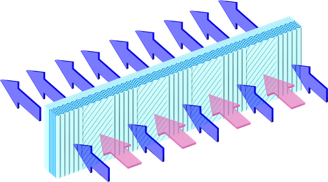Highly Integrated and Precision Devices for Next-generation Optical Communications
State-of-the-art polarization and wavefront control technology

The need for increasing global communication capacity is ongoing and is projected to grow rapidly for the foreseeable future. As evidenced by the coronavirus pandemic, the societal need for video-conferencing, video streaming, IoT, virtual reality, augmented reality, metaverse along among applications are ever increasing. People all ever the world will benefit from faster, cheaper and more innovative communication systems.
The telecommunicationinfrastructure that supports these applications is growing dramatically. Optical communication networks have long been constructed around the world, and optical fibers are widely used as communication lines.
Early optical communication was based on high-speed systems that transmitted signals by simply turning the light intensity on and off, However, this type of system reached practical limits and were not able keep up with increasing in capacity requirements. While it is certainly possible to increase capacity by simply adding optical fibers, the cost of this would amount to billions of dollars especially considering the connection requirements across and between continents. Therefore the focus of technological development over the past 20 years has been on more efficient use of individual optical fibers.
Following the initial high-spped “On/Off” transmission of light, the industry focus turned to optical wavelength multiplexing which greatly enhanced capacity into the early 2000s. However, asincreasing the communication capacity per channel requires a wider bandwidths, and since this bandwidth is limited byoptical fiber, it was clear that a practical limit would eventually be reached.
To further expand transmission capacity, it became necessary to adopt advanced modulation techniques. Digital coherent communications using the intensity, phase and polarization of light was developed, and is now used as the backbone optical communication systems. In addition to multi-leveling by the intensity of light, the phase, which is a feature of lightwave propagation , can be shifted in discrete amounts such as 0, +90, and -90 degrees. Since orthogonal polarizations do not physically mix, different signals can be loaded onto each, doubling the capacity. This technology is commonly used in wireless communications such as mobile phones, and is finally being introduced to the world of lightwave tranmission.
Using such advanced modulation techniques, it has become possible to increase the capacity of a single fiber by 20x or more. Essential to this dramatic increase in fiber transmission capacity, the ability to control the phase and polarization of light, has become a critical element for optical communications.
Our photonic crystal technology can be used to enhance such modulation techniques by realizing free-pattern polarization distributions in a single plane. For example, using photonic crystals it is possible to integrate a function to control the polarization of a multi-channel optical beam within each channel. As integration is a top priority for communication devices, and as our photonic crystal technology increases the degree of freedom in designing such devices, optical communications will become more dependent on our products.

One example is the wavelength-selective optical switch (WSS). WSSs, which can switch channels by wavelength for flexible operation of communication networks, have attracted much attention and can be built by a number of technologies. Among these technologies, liquid crystal on silicon (LCOS), is the most popular method. This method canbe used to distribute signals to multiple channels by electrical control. However, because it uses liquid crystals, the optical system has polarization dependence, and polarization diversity is necessary. In such cases, our multi-channel waveplates can provide significant advantages in terms of high integration, such as the ability to align the polarization of multiple channels simultaneously.
Additionally, photonic crystal waveplates can easily achieve greater birefringence than those using natural optical crystals, which allows them to be made thinner. For example, a half-wave plate that requires a thickness of 90 μm using a quartz plate can be made as thin as 15 μm using photonic crystals. By thinning down the substrate further, a waveplate with a thickness of 15 μm can be realized. By cutting a groove in a planar optical circuit, such an ultra-thin waveplate can be inserted (see: https://www.youtube.com/watch?v=hdd6q0pW4DM )to control polarization in the circuit. This results in a device that functions as a polarization splitter in coherent communication receiver.
It is widely known that the phase of circularly polarized lightwave can be controlled by the orientation of a half-wave plate. Therefore, by combining a waveplate array with an optical element that separates a lightwave into left and right circularly polarized light, it is possible to realize a device that can control the phase of each polarization while splitting the input light. We have demonstrated an optical circuit that combines polarization separation and 90-degree hybridization for receiving coherent communications by simply laminating the elements together (OFC paper). This concept can be applied to phase control in the beam plane, and is expected to be useful in the next generation of higher-order mode transmission in multimode systems.
Photonic Lattice has experience fabricating such an integrated system from design to prototyping and manufacturing. We can respond quickly and flexibly to customer needs.
The key points of photonic crystal technology are polarization “multiplexing” and “integration”.As optical communicationreqirements continue to increase, the beneficial features of of photonic crystals provide an exactmatch to device needs. By developing and supplying devices that take advantage of these features, we plan to contribute to an ever improving information society of the future.


Category
- #Next-generation optical communication solutions
- #Photonic Crystal Polarizing Optical Components
